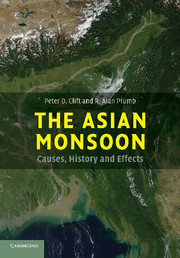Book contents
- Frontmatter
- Contents
- Preface
- Acknowledgements
- 1 The meteorology of monsoons
- 2 Controls on the Asian monsoon over tectonic timescales
- 3 Monsoon evolution on tectonic timescales
- 4 Monsoon evolution on orbital timescales
- 5 Erosional impact of the Asian monsoon
- 6 The Late Holocene monsoon and human society
- References
- Further reading
- Index
- Plate section
4 - Monsoon evolution on orbital timescales
Published online by Cambridge University Press: 01 September 2009
- Frontmatter
- Contents
- Preface
- Acknowledgements
- 1 The meteorology of monsoons
- 2 Controls on the Asian monsoon over tectonic timescales
- 3 Monsoon evolution on tectonic timescales
- 4 Monsoon evolution on orbital timescales
- 5 Erosional impact of the Asian monsoon
- 6 The Late Holocene monsoon and human society
- References
- Further reading
- Index
- Plate section
Summary
Introduction
The Asian monsoon system varies not just over long periods of geologic time (106–107 years), but also on millennial and shorter timescales. In this chapter we explore what is known about this shorter-term development in monsoon intensity and explain some of the processes that control this. Since the onset of icehouse conditions around three million years ago the global climate has largely been linked to, and possibly controlled by, the changing intensity of Northern Hemispheric Glaciation. This, in turn, is now well established as being largely a function of solar energy variations, driven by long-term fluctuations in the Earth's orbit around the Sun (e.g., Hays et al., 1976; Shackleton and Opdyke, 1977; Martinson et al., 1987; Shackleton et al., 1990; Bassinot et al., 1994). Although the link between the growth and retreat of glaciers in the northern hemisphere and the intensity of the Asian monsoon might not be immediately apparent, it has been recognized that major regional climatic phenomena do appear to influence each other through a series of teleconnections. Figure 4.1 shows the proposed connections between different regional oceanographic and climatic systems, in an attempt to demonstrate how changes in one system can feedback and affect climate in other parts of the planet. The two most important teleconnections we shall consider here are those between the El Niño Southern Oscillation (ENSO) system of the Pacific Ocean and the intensity of Northern Hemispheric Glaciation.
- Type
- Chapter
- Information
- The Asian MonsoonCauses, History and Effects, pp. 95 - 158Publisher: Cambridge University PressPrint publication year: 2008



